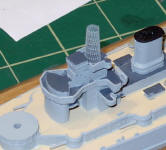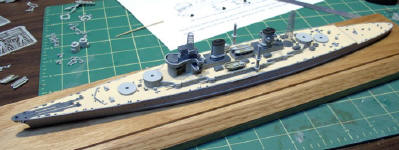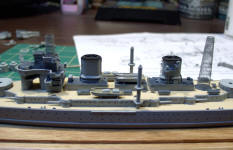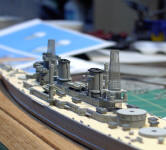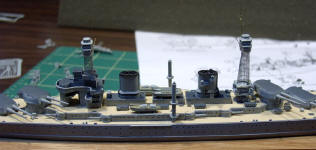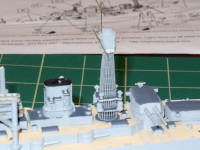Building the Lexington-class
Battle Cruiser Saratoga
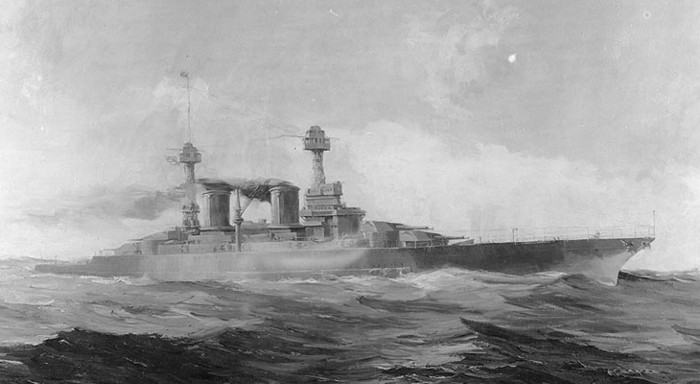
A build up review of the 1/700 Imperial
Hobby Productions kit
by Martin J Quinn
Operational History
Laid down as part of six
Lexington-class
battle cruisers,
Lexington and her sister
Saratoga were converted
to aircraft carriers as a result of the Washington Naval Treaty.
The other planned battle cruisers - Constellation, Ranger,
Constitution
and United States - were scrapped incomplete on the building ways.
Large (they were the largest ships in the world for sometime) and fast,
the two carriers became the test bed and proving ground for US Naval Aviation
in the 20ís the 30ís.
Lexington had an active - albeit
short - career during the war, succumbing to Japanese torpedo and bomb
attacks during the Battle of the Coral Sea in May, 1942. Saratoga
performed solid service during the war, her record being diminished in
some eyes by being torpedoed twice in 1942 and being severely damaged by
kamikazes off Iwo Jima in 1945. Saratoga ended
World War II as a training carrier and before being used as a target during
the post-war atomic bomb tests at Bikini Atoll, where she sank after one
such test in 1946.
Building the Lexington-class
Battle Cruiser Saratoga
Ever since I read "Queen of the Flat-Tops" as a young
lad, the Lexington has been one of my favorite ships.
Then, a few years back, I built the old Fujimi Saratoga.
During my research for that build, I came to appreciate "Sister
Sara's" contribution to the war. I also developed a certain fondness
for Sara since she was built here in New Jersey. While I knew
the two sisters had originally been designed as battlecruisers, it wasn't
until I got Tony Gibbons book, The Complete Encyclopedia of Battleships
(Cresent Books, 1983) that I came to appreciate the "what-if" Lexington-class
Spread out across two pages was a color profile of a graceful, powerful
looking battlecruiser, more elegant than any battlecruiser I'd ever seen,
including HMS Tiger and Hood. So, when Tim Dike
asked me if I wanted to do a build up review of the IHP Lexington-class
kit, I jumped at the opportunity.
I started as I always do, by checking out the
in-box
review here on ModelWarships. Then, I started looking for
references. Outside of the aforementioned Gibbons book, there
aren't many, given that these beauties were never finished as originally
designed. However, the fact that they were never completed
worked in my favor, because it gave me a little leeway in completing the
model.
After washing the model and parts in warm soapy water,
I airbrushed the deck with teak from the White Ensign Models paint line.
I then started to mask the deck in preparation for painting the overall
Standard Gray color, when I noticed the paint was peeling off the deck.
So, I rubbed down the hull with acetone and gave the model another wash
in soapy water, then re-sprayed the deck.
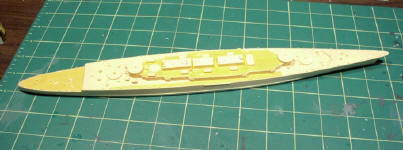
Masking the hull |
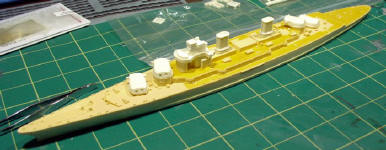
Partially masked deck with dry-fitted pieces |
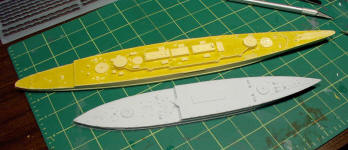
Sara was BIG - Waveline USS Maryland
along side for scale |
Once the deck was dry, and masked it off with Tamiya
masking tape. It was the first time I had used this tape, but
boy, does it work great! It's low tack, goes on well, is very thin
and workable - highly recommended! With the deck masked, I
painted the vertical surfaces with WEM's #20 Standard Deck Gray (While
I had the deck gray out, I also painted the decks of Midship Models USS
Gridley,
seen next to the Saratoga. Again, note the immense size of
these ships as compared to a destroyer). Once this was dry, I masked
the dark gray and painted the entire model and all the loose parts #5 Standard
Navy Gray, again with WEM paints. With the Standard Gray dry, I peeled
off the masking tape to see what I had. Some paint had pulled
up here and there, but overall I was pleased.
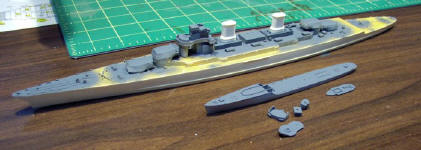
Sara before the #5 Standard Gray was airbrushed
on |
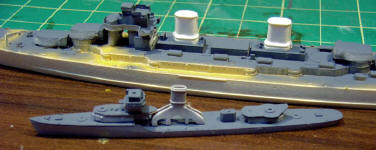
Midship Models DD USS Benham alongside Sara |
Some of the smaller items (turrets/barrels/etc) needed
to be painted again, so I first installed the main armament into the turrets.
The 16" guns are turned brass - a nice touch from IHP - and have locating
holes in the face of the turrets. However, the holes are just a guide,
and each had to be drilled out with a pin vise to get the barrels to fit
properly. The instructions are on a single two-sided piece
of paper. On one side is a drawing and list of the parts, along with
a small plan and profile view of the Lexington-class from Beyer.
In my opinion, the plan/profile view should be included in the same scale
as the kit. On the other side of the instructions are a series
of small exploded views and then a larger exploded view of the entire ship.
I started with the forward superstructure. While studying the
kit parts, I realized the superstructure is very similar to the ones found
on the Big 5 battleships, especially in their "as launched" configuration,
which gave me some additional resources to use.
Upon test fitting the parts, I found Part C1, the top
of the conning tower and navigation bridge, fit correctly onto part C2
- the superstructure - but then there was a gap between Part C1 and Part
A3, the conning tower. I slid a few pieces of scrap plastic
into the gap until I found the right thickness, then cut and glued a piece
onto the top of Part A3. Once it was dry, I trimmed and sanded
it to fit the oval conning tower and test fitted Part C1 again.
This time the fit was perfect. However, I decided to leave
the bridge off for now and work on some of the other details.
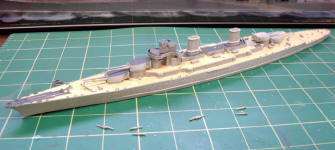 |
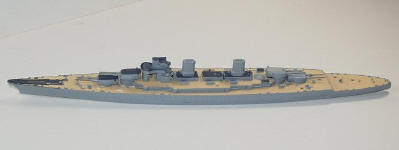
Painted with parts dry fitted |
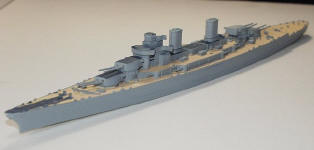 |
I realized that the 6 inch casement guns needed to
be added now, until I got too far along in my build. These barrels
are also turned brass, though I thought they looked a little over scale
once on the model. You may want to replace them with
something smaller, like brass tubing. There are no pilot holes for
the casement guns, as there were on the turrets for the main guns.
IHP - in my opinion - should have included the holes for these.
I got out a drill and a pin vise and started drilling holes for the barrels.
It was difficult to get the drill in to open holes for the guns in the
stowed position, which what I wanted to do. When I was done,
I realized almost all my barrels tilted upwards.
Since the casement guns were now in, I turned my attention
to the 6 inch secondary guns and the 3 inch AA guns. The 6" guns
look like knock-offs of Skywave's 5" guns. About half of the
8 white metal guns had bent barrels. These were easily fixed.
The 3" guns were a different matter. Almost all of them (there are
6) were missing their barrels. I also thought they stood too tall.
I dipped into the spare pool and found similar guns from Skywave.
These guns looked more to scale and didn't sit nearly as high.
All of these guns - both 6" and 3" - were assembled, painted and set aside
to be added later in the build.
Next I added the funnels and then went to glue the platforms
for the aft funnel into place. Both platforms (parts C6 &
C7) were warped. I also thought they were a little over scale,
so I made new ones from evergreen sheet plastic and glued them into place.
I decided to replace the solid "lattice" support structures (parts C11
& C12) with pieces of photo-etch from an old GMM Japanese carrier set
- but not until later.
Once the platforms were dry, I added the posts for
the boat cranes (A5) to either side of the hull. These massive
posts look a little odd here - but the instructions and drawings/profiles
from Beyer and Gibbons both match. They also match the boat cranes
found on the Big 5 battlewagons. The crane posts were warped
- I straightened them before mounting them, but noticed they had a tendency
to bend after time. This part may have been better served being white
metal and not resin. Since the resin "cranes" (part A7) were solid
and too heavy looking, I left them off and elected to add photo-etch cranes
from the Tom's ModelWorks #720 Early US Battleship set (which I originally
bought just to have extra cage masts). The photo-etch cranes
were left aside to be assembled and added later.
I moved back to the superstructure, concentrating on parts
C9 and C10, which were platforms on either side of said superstructure.
The instructions seem to show the platforms being added at the very front
of the superstructure, while the included drawing from Beyer shows them
further back. I elected to go with the drawing.
Once I test fitted them, I found the two platforms protruded out too far
for my taste, so I cut them down and glued them to the side of the superstructure.
I then added some splinter shielding to make the superstructure look uniform
with the platform.
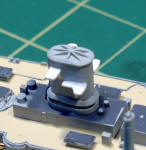
The new platforms on the aft funnel |
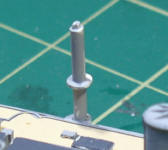
The boat crane before adding photo-etched cranes |
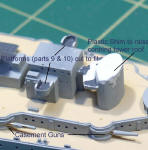
Bridge assembly |
With these platforms in place, I glued part C1 onto
the conning tower and aft bridge (parts A3 & C2). I then
added some splinter shields and platforms around part C2, the aft bridge,
from evergreen plastic strip. After all of this dried, I used
the photo-etch pieces I had mentioned earlier to replicate the supports
under the platforms on the aft funnel.
At this time, before going any further, I mounted the
model onto the base I had ordered from
Micro
Mark. Using a small trowel like took, I spread some acrylic
gel on the bottom of the hull, which was placed and then clamped onto the
base and left to dry overnight.
I now turned my attention to the ships boats - which I
wanted to build and install before I put the photo-etch cranes and finished
the cage masts. Knowing my tendency to be ham-handed, I figured it
was better to get these on now before I started knocking parts off later.
Since there were no boat cradles, I made some from strip styrene, cutting
notches into them for the boats to sit. I made three pairs
and installed them, using the line drawing and instructions as a guide.
They were then painted and the boats mounted. For the center
section of boats, I had to make two more sets of cradles, since these boats
were stacked on top of each other. These had to be painted
before being installed. So, while the paint on the cradles
for the boats were drying, I started making my cage masts.
I have to admit I was a little timid about tackling the
cage masts. I knew I had some leeway, because the photo-etch
set I bought to supplement the kit had extra cage mast in it.
Still...I knew I could go through both sets easily. I
cut the foremast off it's runner, took out a large paintbrush and started
rolling. To my surprise, it wasn't as hard as I thought it
would be. I kept rolling the paintbrush gently over the photo-etch
cage mast, gently bending the mast more and more. Before I
knew it, I had an almost perfectly round mast. The trickiest
part was mating up the two halves of the cage mast. I first brushed
on some accelerator, let that dry, then held the tops of the cage mast
together in my fingers. A drop of CA glue kept the top together,
so I worked my down, mating the seam and adding CA. Once I was done,
I placed it on the top of the forward superstructure and admired my handiwork.
My first cage mast! I did the same thing for the mainmast,
but accidentally glued the top of the mast to the paint brush handle (rrrrr!).
I was able to gently pry the cage mast off the paint brush without too
much damage.
I decided to glue the cage masts to the ship
at this point. I felt I'd cause less damage by adding the fighting
tops to the mounted cage masts, rather than trying to mount them while
holding the cage masts in my hands (I envisions myself pinching the cage
masts together). While test fitting the mainmast, I found that
it was taller than the foremast. After some measuring, I ended
up cutting two "levels" off the mainmast, working from the bottom up.
This brought the cage masts to the same height.
With the cage masts attached, I test fit the fighting
tops. These are probably the roughest cast parts of the model,
with rough casting inside the molded on "windows". The bottoms
come with a protrusion that is supposed to fit inside the cage mast to
help alignment. However, since the typical cage-masted ship
in the USN didn't have this protrusion, I cut them off and sanded the bottoms
of the fighting tops flat. One thing that surprised me when I first
started working with resin was how fast you can sand it - so go slowly
if you sand the fighting tops, lest you sand off too much!
Now that the fighting tops were ready to put on,
I added masts from brass rod. Pictures of the Big 5 show a
slightly different configuration on the foremast than what is shown in
the IHP instruction. I followed the references I had and not the
instructions. Before gluing the fighting tops down, I
added the two platforms on the mainmast. Each was dry-fitted
into place, then tacked down with CA. So now that I had cage masts
and fighting tops installed, I finished the boats. Once these
were glued into place, I added those photo-etched boat cranes from the
Toms Modelworks set to the already mounted post. Once these dried,
I added brass wire from the post to the crane, to replicate the cables
found on the real cranes. I then glued the fore and aft gun directors
into place - the aft gun director being placed on top of "C" turret.
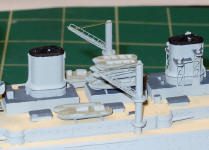
The ships boats and completed boat cranes. |
With the gun directors in place, only a few items
remained to be added to the model: the anchor chain, the small boats
along the main deck and their davits, and the secondary and AA guns.
I now decided it was a good time to do some touch up painting, so I masked
off the base and airbrushed another light coat of #5 Standard Navy Grey
onto the model, being careful not to over spray the vertical surfaced painted
#20 Standard Deck Grey.
Once the paint dried, I started adding the photo-etched
railings. Using some old Accurate Image railings for the USS
Salem that my buddy Jeff had given me, I started with the forward superstructure
and started working my way backwards. The railing of the midships
superstructure areas was especially tedious. With the midships
area done, began railing the boat deck level. If you build
this model, you'll notice there is a raised waterway molded into the side
of the deck on the main, quarter and boat deck levels. This
helps facilitate the installation of the railings - assuming the you actually
notice it.
Or, you can be like me, and notice the waterway AFTER
you have finished one whole side of the boat deck while installing railings
at 1 o'clock in the morning. I'm going to chalk that
one up to being tired and not having gone to bed when I should have.
Anyway, once I realized that I should be gluing the railings on the OUTSIDE
of the waterway, the installation sped along. It took
me about 1/4 of the time to rail the starboard side than compared to the
port side, which is where I had started. With the boat deck
completely done, I got ready to rail the main deck. Before
I added the railings here, I added the anchor chain, which IHP supplies
- another nice touch.
Anchor chain in place, I added the 6" and 3" guns
to the boat deck, then finished adding the railings to the main deck -
speeded along by the use of the aforementioned waterway as guide.
After the main railings were in place, I glued the main battery turrets
to the model. I displayed "C" & "D" turrets turned to port,
because the back of "C" turret and the mainmast touched if the turret was
positioned facing aft. With the turrets secured, I added the
white metal davits and then the white metal boats located on either side
of the main deck by the forward superstructure. When all this
dried, I used some flat black to paint the windows in the bridge and the
fight tops. Once these were dry, the ship was ready for final
touch up painting.
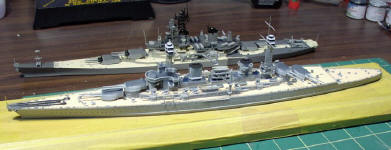
Garden State Firepower
Lexington-class battlecruiser Saratoga
alongside the Tamiya New Jersey - note how similar they are in size,
but not design |
With the touch up painting complete, I used some
ceramic thread to represent the stays for the funnels. I used
the plans and drawing in the Profile Morskie book on the Big 5 as a reference,
but only but four stays per funnel, not the eight stays the PM volume shows.
With the stays in place, the model was ready to be rigged.
The vertical rigging was added with .002 monofilament, while the horizontal
rigging was .003 monofilament. From a Gold Medal
Models decal sheet, I added a US Ensign, then finished the model
with a light coat of flat. Being that the ship represented
a "never completed" battlecruiser, I skipped my usual weathering.
The model is marketed as, and is supposed to represent,
the USS Lexington (CC-1), which would have been a fleet flagship.
I couldn't find any references that indicated any differences between flagships
and non-flagships, so I opted to "christen" my completed Lexington-class
kit as the Battle Cruiser USS Saratoga, (CC-3). Saratoga
was built at the now defunct New York Shipbuilding Corporation, located
in the city of Camden in my home state of New Jersey. (The remains
of the shipyard are located just south of the current site of the Battleship
New
Jersey Museum).
| Conclusion: |

|
| The IHP Lexington presents
an intriguing "what-if". This kit gives the modeler a glimpse
of what the US Navy might have looked like if the Washington Naval Treaty
had not come to pass. The Lexington's - while flawed
- were majestic, powerful looking vessels.
Overall, the hull is well cast, but some of the smaller
resin parts are a bit rough. IHP should have cast some resin parts
(like the crane posts) in white metal, and done a little better quality
control on the AA guns. Additionally, for the cost of the kit
(approx $175 USD), I feel there should have been a complete set of photo-etching
included, not just the cage masts. Finally, the directions
are a little lacking. In the future, I'd like to see IHP include
a separate page with a plan and profile of the ship for reference.
Regardless of these shortcomings, I was pleased
with the model and enjoyed building it very much. I heartily
recommend it to anyone with a few resin kits under their belt who wants
to round out their 1/700 battle fleet. Thanks to Imperial Hobby
Productions for the review sample.
IHP
USS Lexington in-box review |
Here are some pictures of my completed 1/700 Imperial
Hobby Productions Lexington-class Battle Cruiser USS Saratoga,
CC-3:
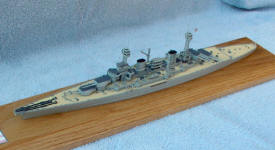 |
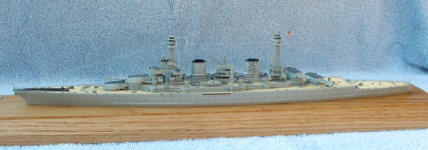 |
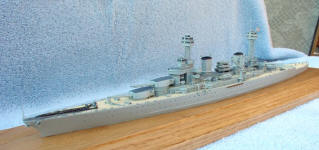 |
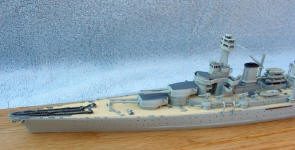 |
 |
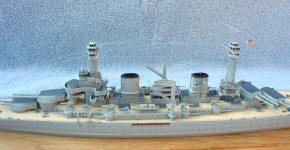 |
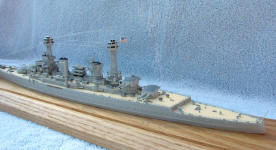 |
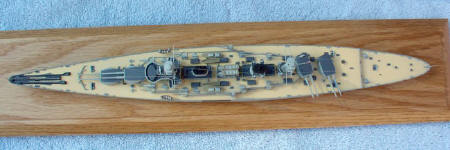 |
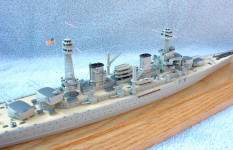 |
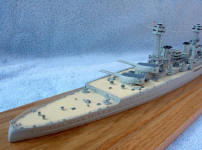 |
 |
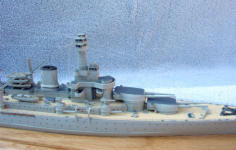 |
 |
 |
| |
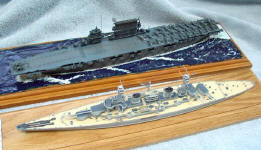
A Tale of Two Saratoga's
As designed (1920) and as completed (1944) |
|

© ModelWarships.com




